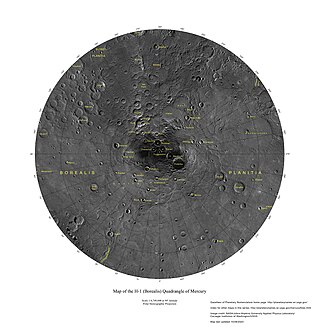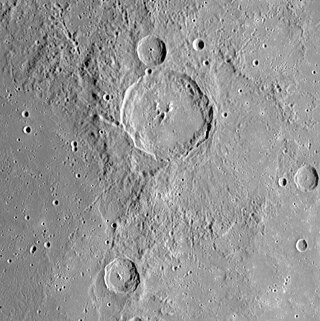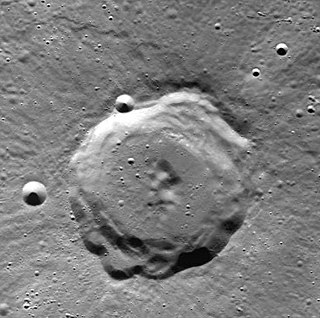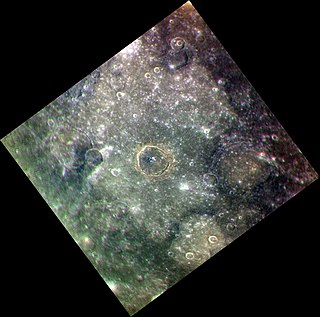
Caloris Planitia is a plain within a large impact basin on Mercury, informally named Caloris, about 1,550 km (960 mi) in diameter. It is one of the largest impact basins in the Solar System. "Calor" is Latin for "heat" and the basin is so-named because the Sun is almost directly overhead every second time Mercury passes perihelion. The crater, discovered in 1974, is surrounded by the Caloris Montes, a ring of mountains approximately 2 km (1.2 mi) tall.

Degas is a rayed crater on Mercury at latitude 37.5 N, longitude 127 W. Its diameter is 54 kilometres (34 mi). It was named after the French impressionist painter Edgar Degas in 1979. The rays consist of light colored material blasted out during the crater's formation. Craters older than Degas are covered by the ray material, while younger craters are seen superimposed on the rays. Degas forms a crater pair with Brontë to the north. Both lie near the center of Sobkou Planitia.

Sobkou Planitia is a large basin on the planet Mercury. It is named after the ancient Egyptian messenger deity Sobkou. He was associated by the Egyptians with the planet Mercury.

Suisei Planitia is a large area of smooth plains on Mercury, approximately 570 km wide. Ghost craters are unusual forms that occur in the Suisei Planitia. They are buried and rounded in profile, with only their rim crests rising above the surrounding smooth plains. It has been suggested that material forming Suisei Planitia is ejecta from the impact that formed Caloris Planitia. The name for this Planitia was approved in 1976 by the IAU.

Tir Planitia is a large plain on the planet Mercury. The name Tir (تیر) is the Persian word for "Mercury",, and the name was approved in 1976. It was first observed in detail by Mariner 10. It lies between the large crater Mozart and the ancient Tolstoj basin.

The Borealis quadrangle is a quadrangle on Mercury surrounding the north pole down to 65° latitude. It was mapped in its entirety by the MESSENGER spacecraft, which orbited the planet from 2008 to 2015, excluding areas of permanent shadow near the north pole. Only approximately 25% of the quadrangle was imaged by the Mariner 10 spacecraft during its flybys in 1974 and 1975. The quadrangle is now called H-1.

The Tolstoj quadrangle in the equatorial region of Mercury runs from 144 to 216° longitude and -25 to 25° latitude. It was provisionally called "Tir", but renamed after Leo Tolstoy by the International Astronomical Union in 1976. Also called Phaethontias.

The Shakespeare quadrangle is a region of Mercury running from 90 to 180° longitude and 20 to 70° latitude. It is also called Caduceata.

The Hokusai quadrangle (H-5) is one of fifteen quadrangles on the planet Mercury. It runs from 360 to 270° longitude and 20 to 70° latitude. Named after the Hokusai crater, it was mapped in detail for the first time after MESSENGER entered orbit around Mercury in 2011. It had not been mapped prior to that point because it was one of the six quadrangles that wasn't illuminated when Mariner 10 made its flybys in 1974 and 1975. These six quadrangles continued to be known by their albedo feature names, with this one known as the Apollonia quadrangle.

Hovnatanian is a crater on Mercury. Its “butterfly” pattern of ejecta rays were created by an impact at an even lower angle than that which formed neighboring Qi Baishi crater. From the "butterfly" pattern of rays, the Hovnatanian impactor was travelling either north-to-south or south-to-north prior to hitting Mercury's surface. Hovnatanian lies to the west of Tir Planitia.

Calvino is a crater on Mercury. Its name was adopted by the IAU in 2016, after the Italian writer Italo Calvino.

Brontë is a crater on Mercury. It has a diameter of 68 kilometres. Its name was adopted by the International Astronomical Union in 1976. Bronte is named for English writers Charlotte Brontë, who lived from 1816 to 1855, Emily Brontë, who lived from 1818 to 1848, and Anne Brontë, who lived from 1820 to 1849, and English writer and artist Branwell Brontë, who lived from 1817 to 1848.

Couperin is a crater on Mercury. It has a diameter of 80 kilometers. Its name was adopted by the International Astronomical Union (IAU) in 1979. Couperin is named for the French composer François Couperin, who lived from 1688 to 1733.

Fet is a crater on Mercury that is named for the Russian poet Afanasy Fet, who lived from 1820 to 1892. Its name was adopted by the International Astronomical Union in 1985. The diameter of the crater is 79 kilometers.

Grieg is a crater on Mercury. It has a diameter of 59 kilometers. Its name was adopted by the International Astronomical Union (IAU) in 1985. Grieg is named after the Norwegian composer Edvard Grieg, who lived from 1843 to 1907.

Rivera is a crater on Mercury. It has a diameter of 40 kilometers. Its name was suggested by Mexican residents Ricardo Martinez and Arturo Gutierrez, and American residents Rebecca Hare and José Martinez, in a naming contest which was eventually adopted by the International Astronomical Union (IAU) on 2015. Rivera is named for the Mexican poet Diego Rivera. The craters Carolan, Enheduanna, Karsh, and Kulthum were also named as part of the contest.

Alver is a crater on Mercury. It has a diameter of 151.49 kilometers. Its name was adopted by the International Astronomical Union (IAU) on March 15, 2013. Alver is named for the Estonian poet Betti Alver.

Sihtu Planitia is a large plain on Mercury, approximately 565 km across. It was named in 2017 by the IAU. The crater Calvino lies at the center of the Planitia, and Rūdaki is on the east side.

Apārangi Planitia is a large plain on Mercury, approximately 1077 km across. It was named in 2017 by the IAU.

Mearcair Planitia is a large plain on the planet Mercury. The name Mearcair is the Irish word for "Mercury", and the name was approved in 2017. It was first observed in detail by MESSENGER. It lies between the large crater Raditladi and the ancient Caloris basin.




















